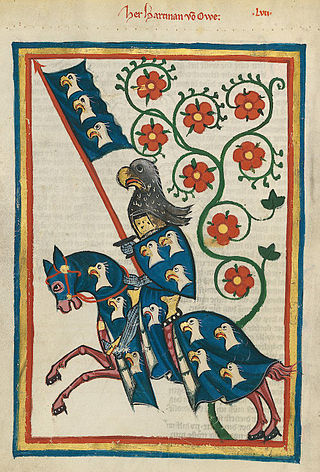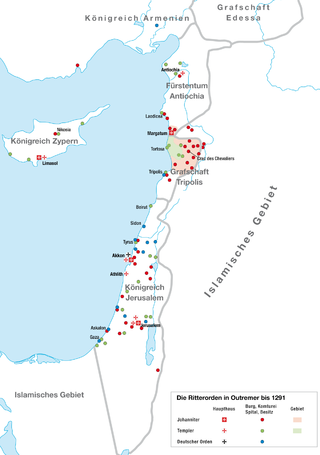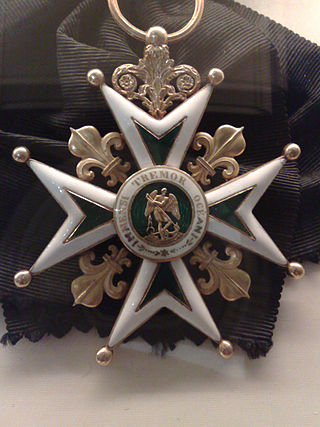
A knight is a person granted an honorary title of knighthood by a head of state or representative for service to the monarch, the church or the country, especially in a military capacity.

Chivalry, or the chivalric language, is an informal and varying code of conduct developed in Europe between 1170 and 1220. It is associated with the medieval Christian institution of knighthood, with knights being members of various chivalric orders; knights' and gentlemen's behaviours were governed by chivalrous social codes. The ideals of chivalry were popularized in medieval literature, particularly the literary cycles known as the Matter of France, relating to the legendary companions of Charlemagne and his men-at-arms, the paladins, and the Matter of Britain, informed by Geoffrey of Monmouth's Historia Regum Britanniae, written in the 1130s, which popularized the legend of King Arthur and his knights of the Round Table.

A military order is a Christian religious society of knights. The original military orders were the Knights Templar, the Knights Hospitaller, the Order of Saint James, the Order of Calatrava, and the Teutonic Knights. They arose in the Middle Ages in association with the Crusades, both in the Holy Land, the Baltics, and the Iberian peninsula; their members being dedicated to the protection of pilgrims and Christians, as well as the defence of the Crusader states. They are the predecessors of chivalric orders.

The Distinguished Order of the Golden Fleece is a Catholic order of chivalry founded in Bruges by Philip the Good, Duke of Burgundy, in 1430, to celebrate his marriage to Isabella of Portugal. Today, two branches of the order exist, namely the Spanish and the Austrian Fleece; the current grand masters are King Felipe VI of Spain and Karl von Habsburg, head of the House of Habsburg-Lorraine, respectively. The Grand Chaplain of the Austrian branch is Cardinal Christoph Schönborn, Archbishop of Vienna.
The fount of honour is a person, who, by virtue of their official position, has the exclusive right of conferring legitimate titles of nobility and orders of chivalry on other persons.

The Archdiocese of Besançon is a Latin Church ecclesiastical territory or archdiocese of the Catholic Church in France. It comprises the département of Doubs and the département of Haute-Saône.

The Order of Saint Lazarus of Jerusalem, also known as the Leper Brothers of Jerusalem or simply as Lazarists, was a Catholic military order founded by Crusaders around 1119 at a leper hospital in Jerusalem, Kingdom of Jerusalem, whose care became its original purpose, named after its patron saint, Lazarus. It was recognised by King Fulk in 1142 and canonically recognised as a hospitaller and military order of chivalry under the rule of Saint Augustine in the Papal bull Cum a Nobis Petitur of Pope Alexander IV in 1255. Although they were centred on their charism of caring for those afflicted with leprosy, the knights of the Order of Saint Lazarus notably fought in the Siege of Acre in 1191, Arsuf, and in the 1192 Battle of Jaffa. Battle of La Forbie in 1244 and in the Defense of Acre in 1291. The titular seat was successively situated at Jerusalem, then Acre. After the fall of the Kingdom of Jerusalem, the order split into two main branches – in Italy and in France.

The Order of Saint Michael is a French dynastic order of chivalry, founded by King Louis XI of France on 1 August 1469, in response to the Order of the Golden Fleece founded by Philip the Good, Duke of Burgundy, Louis' chief competitor for the allegiance of the great houses of France, the dukes of Orléans, Berry, and Brittany. As a chivalric order, its goal was to confirm the loyalty of its knights to the king. Originally, there were a limited number of knights, at first thirty-one, then increased to thirty-six including the king. An office of Provost was established in 1476. The Order of St Michael was the highest Order in France until it was superseded by the Order of the Holy Spirit.
A dynastic order, monarchical order, or house order is an order under royal patronage. Such an order is bestowed by, as a legitimate fons honorum, a sovereign or the head of a once-sovereign ruling family. These are often considered part of the cultural patrimony of the ruling family. Dynastic orders were often founded or maintained to reward service to a monarch or their subsequent dynasty.

The accolade was the central act in the rite of passage ceremonies conferring knighthood in the Middle Ages.

An order of chivalry, order of knighthood, chivalric order, or equestrian order is an order of knights, typically founded during or inspired by the original Catholic military orders of the Crusades and paired with medieval concepts of ideals of chivalry.

The Order of the Holy Spirit, is a French order of chivalry founded by Henry III of France in 1578. Today, it is a dynastic order under the House of France.
Commander, or Knight Commander, is a title of honor prevalent in chivalric orders and fraternal orders.

The Order of Saint Joachim is an order of chivalry founded in 1755 to promote religious tolerance in Europe, and continues to exist today. Admiral Horatio Nelson accepted the Grand Cross of the Order in 1802.

The Order of the Ancient Nobility, also called Order of the Four Roman Emperors or Ancient Order of Saint George, is a historic chivalric order, first established in 1308. It was re-founded as a secular community on 6 December 1768 by Count Philipp Ferdinand of Limburg-Stirum.
A self-styled order or pseudo-chivalric order is an organisation which claims to be a chivalric order, but is not recognised as legitimate by countries or international bodies. Most self-styled orders arose in or after the mid-18th century, and many have been created recently. Most are short-lived and endure no more than a few decades.
This page is a list of the orders of chivalry and orders of merit awarded by France, in the order they were established or incorporated in France, and their origins.
The orders, decorations, and medals of the Holy See include titles, chivalric orders, distinctions and medals honoured by the Holy See, with the Pope as the fount of honour, for deeds and merits of their recipients to the benefit of the Holy See, the Catholic Church, or their respective communities, societies, nations and the world at large.

The Military and Hospitaller Order of Saint Lazarus of Jerusalem is a Christian order that was statuted in 1910 by a council of Catholics in Paris, France, initially under the protection of Patriarch Cyril VIII Geha of the Melkite Greek Catholic Church. During the 1920s, it expanded its jurisdiction and enrolled members from other countries in Europe and in the Americas. It re-established the office of grand master in 1935, linking the office to members of the Spanish branch of the House of Bourbon. It assumed an ecumenical dimension during the 1950s to expand its membership to individuals of other Trinitarian Christian denominations in British Commonwealth countries.
The Vilatte orders are awards or decorations associated with Joseph René Vilatte which include the Order of the Crown of Thorns (OCT) and the Order of the Lion and the Black Cross (OLBC). Both are condemned by the Holy See and Italy lists both as illegal decorations.












